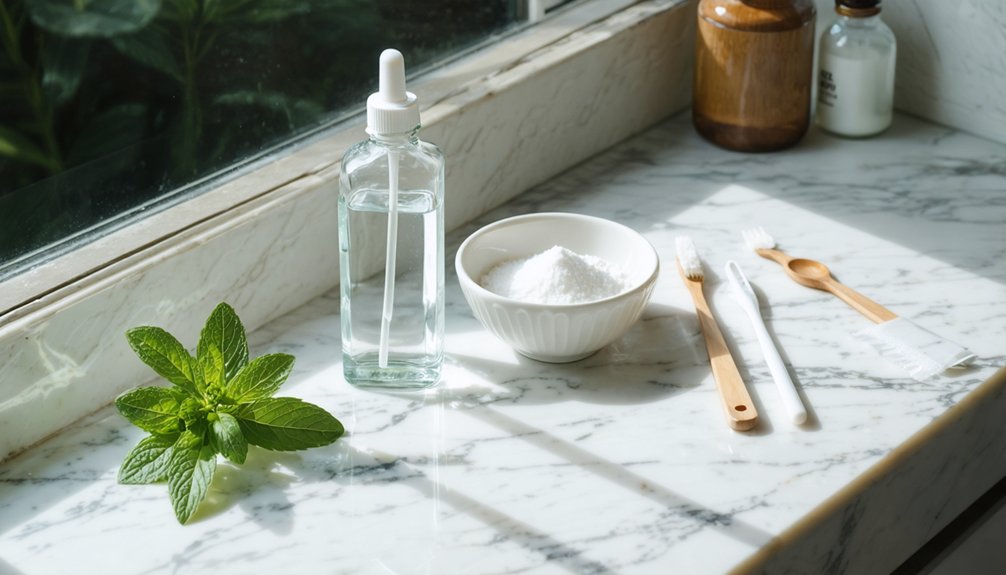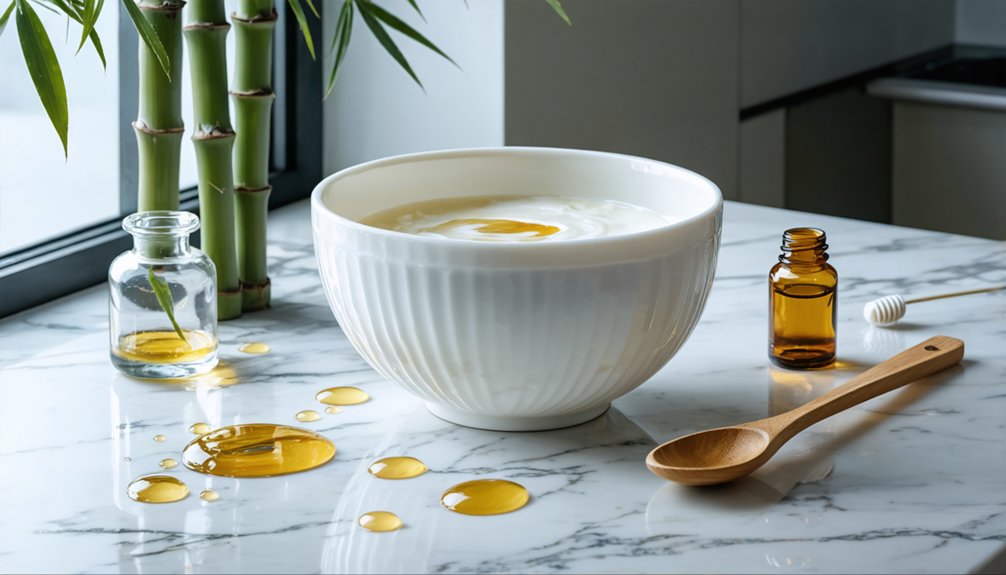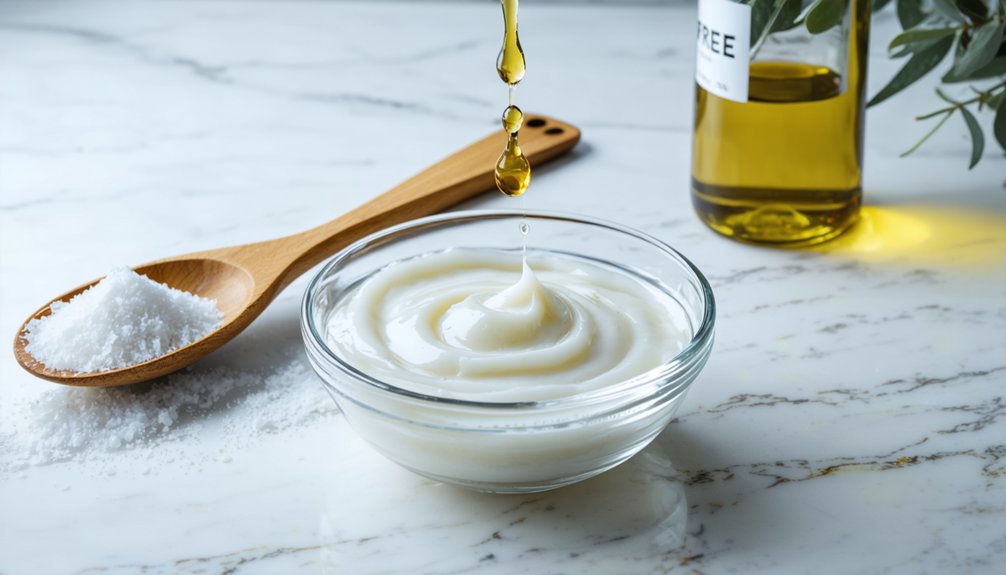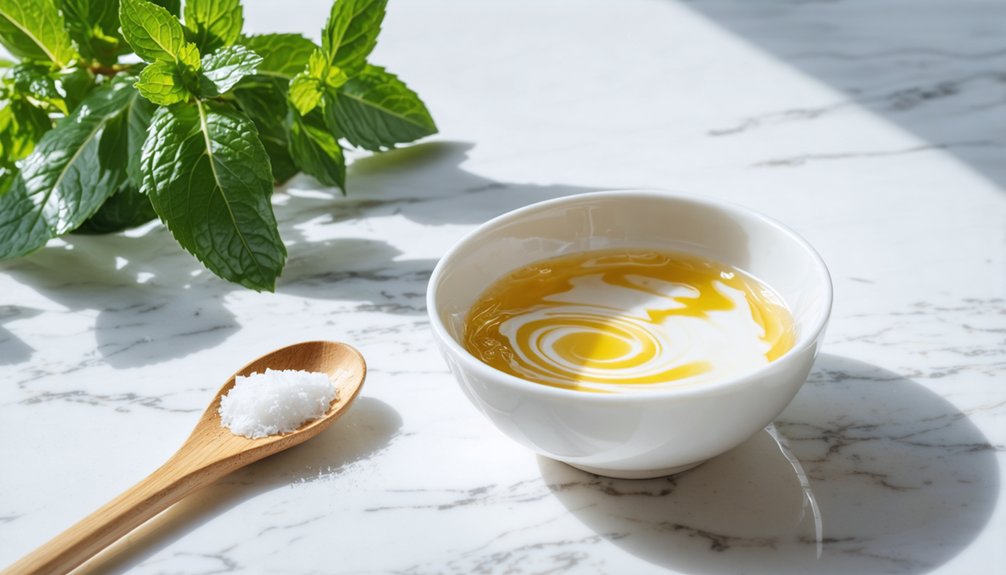You can naturally whiten your teeth using tea tree oil by creating a diluted mixture with coconut oil for safe oil pulling. Never use undiluted tea tree oil, as it can cause chemical burns. Mix 1-2 drops with a tablespoon of coconut oil, swish for 15-20 minutes daily, and spit into a trash bin. Track your progress with weekly photos. Proper application techniques and safety guidelines will help you achieve ideal whitening results.
Key Takeaways
- Mix 2-3 drops of tea tree oil with one tablespoon of coconut oil and a teaspoon of baking soda for a natural whitening paste.
- Perform oil pulling with the mixture for 15-20 minutes daily, ensuring thorough coverage between teeth and along gum lines.
- Apply the whitening paste using a soft-bristled toothbrush twice weekly, avoiding direct contact with undiluted tea tree oil.
- Store homemade whitening paste in an airtight container and always perform a patch test before first use.
- Document progress with weekly photos while maintaining regular dental hygiene and discontinue if irritation occurs.
Understanding Tea Tree Oil’s Benefits for Dental Health
While tea tree oil has gained popularity in various health applications, its proven benefits for dental health deserve special attention. The oil’s powerful antimicrobial benefits target harmful bacteria like Streptococcus mutans and Porphyromonas gingivalis, which cause tooth decay and gum disease. Its active compound, terpinen-4-ol, effectively destroys bacteria, viruses, and fungi in your mouth. Research shows tea tree oil promotes tertiary dentine formation in damaged teeth.
When you incorporate tea tree oil into your oral hygiene routine, you’ll find it offers advantages over traditional chemical antiseptics. Studies show it reduces plaque buildup and gum inflammation without causing tooth staining or severe taste alterations. Tea tree oil is particularly effective in treating oral candida infections when used as a mouthwash solution.
At concentrations of 0.2-0.5%, tea tree oil mouthwash effectively decreases bacterial counts for up to two weeks after treatment, supporting long-term oral health while being gentler on your mouth than chlorhexidine.
Natural Teeth Whitening Properties of Tea Tree Oil
Beyond tea tree oil’s established dental health benefits, its natural whitening properties offer a gentle alternative to harsh chemical treatments. When you incorporate tea tree oil into your oral care routine, you’ll benefit from its natural bleaching capabilities that help reduce surface stains from coffee, tea, and other discoloring substances. The recommended twice daily brushing helps maximize these whitening effects.
The terpinen-4-ol compound found in tea tree oil actively fights bacteria that cause staining and discoloration.
Its antibacterial properties combat plaque-causing bacteria that can lead to discoloration, while simultaneously supporting a healthier oral environment.
- Picture your teeth gradually becoming brighter as tea tree oil’s gentle whitening action works day by day
- Visualize a protective shield forming against new stains as the oil’s compounds fight harmful bacteria
- Imagine your smile getting healthier as inflammation reduces and gum health improves
For best results, combine tea tree oil with other natural ingredients like baking soda in your daily oral care routine.
Essential Safety Guidelines Before Starting

Before attempting any teeth whitening with tea tree oil, you must understand essential safety protocols to prevent adverse reactions and potential harm.
Never use undiluted tea tree oil in your mouth, as it can cause chemical burns and severe tissue irritation. Instead, dilute a few drops with a tablespoon of carrier oil like coconut or olive oil.
Tea tree oil’s anti-inflammatory properties help reduce gum swelling while whitening teeth. Perform a 24-hour patch test on your skin to check for sensitivity reactions before oral use. If you experience redness, swelling, or burning, discontinue use immediately and consult your dentist.
Limit applications to once or twice weekly for safe usage, and always spit out the mixture thoroughly – tea tree oil is toxic if swallowed. Using properly formulated tea tree oil toothpaste with safe concentrations is a better alternative for daily use.
Consult your healthcare provider before starting, especially if you’re pregnant, nursing, or taking medications that might interact with essential oils.
Required Materials and Ingredients
To begin your teeth whitening journey, you’ll need five essential ingredients and three basic tools that guarantee safe and effective treatment. Gather high-quality tea tree oil, baking soda, coconut oil, peppermint oil, and optional hydrogen peroxide from trusted sources. These ingredients provide antimicrobial and therapeutic benefits while supporting natural teeth whitening. When ingredient sourcing, ascertain you’re selecting food-grade or therapeutic-grade products to maintain safety standards. For enhanced whitening results, consider incorporating a fluoride-based toothpaste into your routine.
- A small glass or ceramic mixing bowl prevents chemical reactions that might occur with metal containers
- A non-metal spoon or spoonula guarantees proper blending without contamination
- A soft-bristled toothbrush dedicated specifically to your whitening treatments
While commercial whitening alternatives exist, these natural ingredients offer a gentler approach to teeth whitening. Keep all materials clean and stored in a cool, dry place to maintain their effectiveness and prevent contamination.
Step-by-Step Oil Pulling Method
To begin oil pulling, you’ll measure one tablespoon of coconut oil and let it liquefy in your mouth before starting a gentle swishing motion between your teeth and gums.
You’ll need to maintain consistent swishing for 15-20 minutes daily, preferably in the morning before eating, while being careful not to swallow any oil during the process. After completing your session, always dispose of the oil in a waste basket to prevent plumbing issues.
If you experience jaw fatigue or mild gagging initially, you can start with shorter 1-2 minute sessions and gradually increase your duration while keeping the swishing motion gentle and controlled. The practice helps remove plaque bacteria that causes teeth to yellow over time.
Proper Oil Mixing Ratios
Proper oil mixing ratios form the foundation of safe and effective oil pulling with tea tree oil. When preparing your mixture, combine 1 tablespoon (15 ml) of carrier oil with just 1 drop of tea tree oil to achieve the ideal 0.5-1% dilution ratio. Coconut oil serves as the preferred carrier oil due to its natural antimicrobial properties and pleasant taste.
- Measure your carrier oil carefully using a clean measuring spoon to guarantee precise ratios.
- Add tea tree oil drop-by-drop, avoiding excess that could cause irritation.
- Mix oils thoroughly with gentle swirling motions until fully blended.
Always prepare fresh mixtures for each use and discard any leftovers to maintain potency.
This careful oil dilution approach guarantees you’ll get maximum benefits while protecting your oral tissues from potential sensitivity or adverse reactions.
Daily Pulling Routine Steps
Now that you’ve mastered the oil mixing ratios, implementing a systematic oil pulling routine will maximize your results.
Begin your daily routine by measuring one tablespoon of oil before eating or drinking anything in the morning.
Place the oil in your mouth, allowing coconut oil to naturally melt from your body heat. Gently swish for 10-20 minutes, ensuring the oil reaches between teeth and along gum lines.
Don’t swallow the oil, as it contains collected bacteria and toxins. When finished, spit into a trash bin to prevent plumbing issues.
Rinse thoroughly with warm water, then wait 10-15 minutes before eating or drinking.
To enhance the oil benefits, you may brush gently afterward. Monitor your oral response and adjust the frequency if you experience any sensitivity.
Managing Common Side Effects
While oil pulling offers effective teeth whitening benefits, understanding how to manage potential side effects is essential for safe, long-term use.
If you experience common irritations like burning or swelling, immediately discontinue use and rinse thoroughly with water. To prevent allergic reactions, always perform a patch test before starting your whitening routine, and dilute tea tree oil properly with carrier oils like coconut or olive oil.
- Apply 1-2 drops of tea tree oil mixed with a tablespoon of carrier oil to minimize tissue sensitivity
- Limit oil pulling sessions to 30-60 seconds and space treatments throughout the week
- Monitor your gums and oral tissues for redness, itching, or inflammation after each use
If persistent discomfort occurs, consult your dentist before continuing the treatment.
Creating Your Own Whitening Paste

Making your own teeth whitening paste requires careful attention to ingredient selection and proper ratios.
Start by melting organic coconut oil until liquid, then blend in 10-15 drops of tea tree oil for antibacterial properties. Add finely ground xylitol to the warm mixture, stirring until dissolved.
Blend melted coconut oil with tea tree oil’s natural antibacterial power, then stir in xylitol until completely incorporated.
Carefully incorporate baking soda and your choice of bentonite or Rhassoul clay until achieving a creamy consistency.
For enhanced whitening effects, you’ll need to store your paste in a sterilized, airtight container and apply it with a dry toothbrush. Brush gently for one minute to protect your enamel.
You can customize your paste by adding calcium powder for mineral support or natural essential oils like clove for additional antibacterial benefits.
Remember to avoid rinsing the paste down drains to prevent clogging.
Best Practices for Application and Use
Proper application of any teeth whitening product determines its safety and effectiveness, including homemade solutions.
When using tea tree oil for oral hygiene, you’ll need to follow strict dilution guidelines to prevent irritation. Never use undiluted tea tree oil directly in your mouth, and always mix 1-2 drops with your regular toothpaste or create a rinse with 2-5 drops in warm water.
- Dispense toothpaste onto your brush, add one drop of tea tree oil, then brush normally for two minutes
- Mix 3 drops of tea tree oil in half a glass of warm water, swish for 30-60 seconds, then spit out
- Dip a cotton swab in diluted tea tree oil solution and gently apply to teeth once weekly
Monitor your oral health closely and discontinue use if you experience any sensitivity or adverse reactions.
Combining Tea Tree Oil With Other Natural Whiteners

Tea tree oil’s natural whitening potential can be enhanced when thoughtfully combined with other natural ingredients.
You’ll find coconut oil makes an excellent base, helping dilute tea tree oil‘s potency while maintaining its antimicrobial benefits. For ideal stain removal, combine these oils with baking soda to create a gentle, natural cleaning paste.
Consider adding peppermint oil for fresh breath and additional antibacterial action, or clove oil to address sensitivity while supporting gum health.
While clinical studies haven’t confirmed enhanced whitening effects, these combinations can improve overall oral hygiene.
When experimenting with natural agents, remember that gentle application is key – particularly with abrasive ingredients like salt or baking soda. Start with small amounts and adjust based on your comfort level.
Monitoring Results and Maintaining Progress
To effectively gauge your teeth whitening progress with tea tree oil, establishing clear baseline measurements and implementing a consistent monitoring system is essential. Document your starting point using standardized indices for plaque and bleeding, along with clear photographs or shade measurements.
You’ll want to track your progress weekly or biweekly, comparing current results to your baseline data.
- Maintain detailed records of gum health changes, including any reduction in bleeding or inflammation.
- Document tooth color transformations through consistent photography in natural lighting.
- Monitor for and note any sensitivity or adverse reactions that may develop.
For effective maintenance strategies, integrate diluted tea tree oil products into your daily oral care routine while continuing regular dental hygiene practices.
If you notice any plateaus or setbacks, consider adjusting your technique or consulting a dental professional.
Professional Tips for Enhanced Results
Maximizing your teeth whitening results requires a strategic combination of essential oil applications and proven dental practices. You’ll achieve superior outcomes by incorporating tea tree oil into your daily oral hygiene routine while following professional safety guidelines.
Start by diluting tea tree oil properly and combining it with complementary oils like peppermint or clove for enhanced antimicrobial benefits. Add a few drops to your regular toothpaste or create a natural mouth rinse.
Consider oil pulling with coconut oil as a supplementary practice to boost results. Remember to maintain consistent application times and frequencies while monitoring your gum sensitivity.
For best results, pair your essential oil treatments with a balanced diet and regular dental checkups. You’ll notice improved outcomes when you combine these natural approaches with professional dental guidance.
Frequently Asked Questions
Can I Use Tea Tree Oil Teeth Whitening While Wearing Braces?
You can use diluted tea tree oil while wearing braces, but make it part of your oral hygiene routine carefully. Focus on gentle swishing for braces maintenance, and always consult your orthodontist first.
How Long Should I Wait After Eating Before Using Tea Tree Oil Treatments?
You’ll want to wait at least 30 minutes after eating before any oil application. For ideal results with tea tree treatments, brush your teeth first and maintain consistent whitening frequency.
Will Tea Tree Oil Stain My Dental Crowns or Veneers?
You won’t experience staining of your dental crowns or veneers from tea tree oil. Unlike coffee or wine, tea tree doesn’t contain staining compounds and won’t discolor your dental restorations.
Can Children Safely Use Tea Tree Oil for Teeth Whitening?
No, you shouldn’t use tea tree oil for children’s dental health. It’s toxic if swallowed and poses serious safety risks. Instead, consult a pediatric dentist for safe, approved teeth whitening options.
Does Tea Tree Oil Interfere With Prescription Medications When Used Orally?
You shouldn’t consume tea tree oil under any circumstances, regardless of medication interactions. It’s toxic when taken orally and can cause severe harm, even without considering potential drug effects.
References
- https://www.journaljammr.com/index.php/JAMMR/article/view/5206
- https://pubmed.ncbi.nlm.nih.gov/38864380/
- https://www.hbnobulk.com/blogs/natural-essential-oils/tea-tree-oil-toothpaste-benefits-safety-and-best-options
- https://www.trysnow.com/blogs/news/tea-tree-oil-on-teeth
- https://atglenfamilydentistry.com/essentail-oils-for-teeth-whitening/
- https://raleighdentalloft.com/benefits-of-essential-oils-for-teeth-whitening/
- https://www.colgate.com/en-sg/oral-health/brushing-and-flossing/detox-mouthwash-oil-pulling-natural-oral-care-remedies-1215
- https://pmc.ncbi.nlm.nih.gov/articles/PMC7069753/
- https://www.todaysrdh.com/oral-benefits-of-tea-tree-oil/
- https://www.nature.com/articles/s41598-025-15303-2



